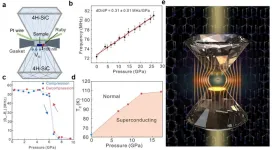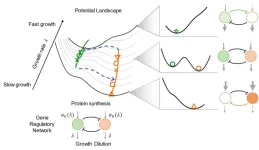(Press-News.org) The impact of multi-storey building design considerations on embodied carbon emissions, cost, and operational energy has been revealed for the first time.
Using a computer model, researchers estimate that up to six gigatonnes of carbon could be saved by 2050 if new multi-storey buildings follow certain recommendations during the design process. All these recommendations, which could also save between 28 and 44% of annual heating and cooling costs, use technology that is currently available.
Construction and operation of buildings account for more than one-third of global emissions and energy use. While buildings are a large part of the current problem, they are also a significant lever for change, say researchers from the Universities of Cambridge and Bath, who explored the decisions architects, engineers and urban planners must negotiate. For their study, the researchers looked at shape, size, layout, structural system, windows, insulation, ventilation, and use parameters, for both residential and office buildings, across different climates.
The researchers built a model that allowed them to estimate, for the first time, the relative importance of these early-stage design decisions in a whole building context. Their findings are reported in the journal Applied Energy.
The study found that increasing building compactness, using steel or timber instead of concrete frames, smaller windows with the optimal glazing for a given climate, and using mechanical ventilation with heat recovery, are the best way to decrease embodied emissions and operational energy. The most significant effects on construction costs meanwhile, were the choice of frame material and whether to install mechanical ventilation.
What determines embodied carbon?
For both residential and office buildings, the choice of structural frame type has a large effect on both embodied carbon – the amount of carbon emitted by the construction of a building – and cost. The researchers found that cheaper frame types tend to be more carbon intensive and vice versa, pointing to a significant trade-off. In comparison, the lowest carbon solutions are cross-laminated timber floor slabs with laminated beams or steel frames. Meanwhile, as the number of storeys increases, so do the embodied carbon values.
The choice of cladding is also a significant factor, with brick cladding leading to significantly higher embodied carbon and cost compared to lighter sheet or tile cladding options. This has a knock-on effect, with further increases in material quantities needed for a structural frame to support the higher cladding loads. Brick clad buildings – which are still widely popular in the UK – were found to be up to 20% more carbon intensive and 15% more expensive than sheet or tile clad buildings.
What determines operational energy?
For temperate climates, such as that of London, a building’s shape and its window configurations are the most impactful design decisions for heating and cooling.
For the tropical climates of Singapore or Lagos however, high humidity and high temperatures mean there is a reliance on cooling. The more occupants within the building, the more cooling energy is needed to dehumidify incoming air.
In the hot and arid climate of Cairo, decisions about window-to-wall ratios are critical. The more windows there are, the more the building heats up through solar radiation. The researchers found that smaller windows and a lower solar heat gain coefficient (the fraction of solar radiation admitted through a window) has more influence on the efficiency of office buildings than it does on residential buildings. This is due to the former having a larger number of occupants and heat-emitting appliances.
By examining the influence of climate on the sensitivity of building design variables, the researchers found that it is much more challenging to reduce energy use in hot and humid climates than in cold and moderate climates.
The use of mechanical ventilation with heat recovery is one of the most important levers to decrease heating and cooling energy, say the researchers, especially for office buildings in hot, humid, and cold climates. The ventilation choice comes with higher upfront costs, but it is a trade-off that the researchers feel should be a central consideration in building design, especially in light of climate change, which already disproportionally affects developing countries and which will inevitably push more of the world’s population into hotter climates.
Lead author Dr Hannes Gauch, Research Associate in Embodied Energy/Emissions of Construction at the Department of Engineering, University of Cambridge, said: “It was surprising to us that insulation thickness and thermal mass, which are usually given a lot of consideration by building designers and researchers, are minor factors in determining the efficiency of a building. Choosing lightweight cladding over brick, for example, has a much more significant impact. Our findings show that to design low carbon buildings we need to focus on efficient shapes (boxy) and structural frames (shorter spans, more timber), limit window sizes, and employ ventilation with heat recovery.”
END
What really matters in multi-story building design?
2023-03-23
ELSE PRESS RELEASES FROM THIS DATE:
UTEP joins project to 3D print batteries from lunar and Martian soil
2023-03-23
EL PASO, Texas (March 23, 2023) – The University of Texas at El Paso has joined a project led by NASA to leverage 3D-printing processes with the aim of manufacturing rechargeable batteries using lunar and Martian regolith, which is the top layer of materials that covers the surface of the moon and Mars.
“UTEP is a national leader in additive manufacturing for space applications,” said Kenith Meissner, Ph.D., dean of the UTEP College of Engineering. “I congratulate the team of UTEP researchers involved in this important work. I am confident their work will add significant value ...
For stressed-out grad students, mindfulness makes big difference
2023-03-23
MADISON – While recent studies and polls indicate the nation is in the midst of a mental health crisis, the situation in academia is even more grim: Within the high-stress, high-pressure, often socially isolated world of advanced education, graduate students experience depression and anxiety at six times the rate of the general population.
Normalizing mindfulness practices within the graduate student experience may be an answer, according to a three-year study conducted by University of Wisconsin–Madison ...
Alzheimer's early detection through biomarkers -
2023-03-23
Scientists from Swansea University ‘s Institute for Innovative Materials, Processing and Numerical Technologies (IMPACT) and Japan have been awarded £1.3 million to develop a new “point of care testing” kit that can detect biomarkers for Alzheimer's Disease.
The project follows Dr Sanjiv Sharma’s ground-breaking work in this area and the development of the world’s first COVID-19 ‘smart patch’.
Compared to hypodermic single needles, a ‘smart patch’ consists of a collection of tiny needles - microneedles - created to break the skin barrier in a minimally invasive ...
Rates of autism climb to new highs in the U.S., with California setting record numbers
2023-03-23
New federal studies coauthored by autism experts at Rutgers found that more children have been diagnosed with autism than at any time since monitoring began more than two decades ago.
According to the U.S. Centers for Disease Control and Prevention (CDC), about 4 percent of 8-year-old boys and 1 percent of 8-year-old girls, have autism in the U.S. These estimates are the highest since the CDC’s Autism and Developmental Disabilities Monitoring (ADDM) Network was created in 2000.
Biennial studies from the ADDM Network, which analyzed ...
Study uncovers aspect of how muscular dystrophies progress
2023-03-23
A research study has shed new light on how congenital muscular dystrophies such as Walker-Warburg syndrome progress, bringing hope for better understanding, early diagnosis and treatments of these fatal disorders.
Published in March in the Journal of Biological Chemistry, the research was led by scientists in the lab of Vlad Panin, Ph.D., professor in the Department of Biochemistry and Biophysics in the Texas A&M College of Agriculture and Life Sciences. The study is titled “Protein tyrosine phosphatase 69D is a substrate of protein O-mannosyltransferases 1-2 that is required for the wiring of sensory axons in Drosophila.” ...
Researchers make breakthrough in high-pressure magnetic detection
2023-03-23
According to a study published in Nature Materials, a collaborative research team from the Hefei Institutes of Physical Science of the Chinese Academy of Sciences (CAS) and the University of Science and Technology of China has developed a research platform to study superconducting magnetic detection and magnetic phase transitions of hydrides under high pressure.
High-resolution in-situ magnetic measurement under high pressure has been a challenge. It has limited the progress of research on the Meissner effect of superconductivity and on magnetic phase transition behavior under high pressure. Using the optically detected ...
Cellular growth rate reshapes cell-fate-decision landscape
2023-03-23
Genes and the regulation relationships among them create complex networks that determine cell differentiation trajectories. However, we still cannot understand and predict the cell-fate-decision process using network topology in a bottom-up manner.
Recently, a research group led by Prof. FU Xiongfei from the Shenzhen Institute of Advanced Technology (SIAT) of the Chinese Academy of Sciences (CAS) has revealed how the global regulation factor, cellular growth rate, reshapes the cell-fate-decision landscape.
The ...
Where does your brain want to have lunch?
2023-03-23
New research published by investigators at Cedars-Sinai advances scientific understanding of how the brain weighs decisions involving what people like or value, such as choosing which book to read, which restaurant to pick for lunch—or even, which slot machine to play in a casino. Published today in the peer-reviewed journal Nature Human Behaviour, this study involved recording the activity of individual human neurons.
The study examined decisions called value-based choices, where there is ...
Microplastics limit energy production in tiny freshwater species
2023-03-23
Microplastic pollution reduces energy production in a microscopic creature found in freshwater worldwide, new research shows.
Paramecium bursaria contain algae that live inside their cells and provide energy by photosynthesis.
The new study, by the University of Exeter, tested whether severe microplastic contamination in the water affected this symbiotic relationship.
The results showed a 50% decline in net photosynthesis – a major impact on the algae’s ability to produce energy and release ...
SwRI, JPL study suggests explanation for unusual radar signatures of icy satellites in the outer solar system
2023-03-23
SAN ANTONIO — March 23, 2023 —A study co-authored by Southwest Research Institute Senior Research Scientist Dr. Jason Hofgartner explains the unusual radar signatures of icy satellites orbiting Jupiter and Saturn. Their radar signatures, which differ significantly from those of rocky worlds and most ice on Earth, have long been a vexing question for the scientific community.
“Six different models have been published in an attempt to explain the radar signatures of the icy moons that orbit Jupiter and Saturn,” said Hofgartner, first author of the study, ...





